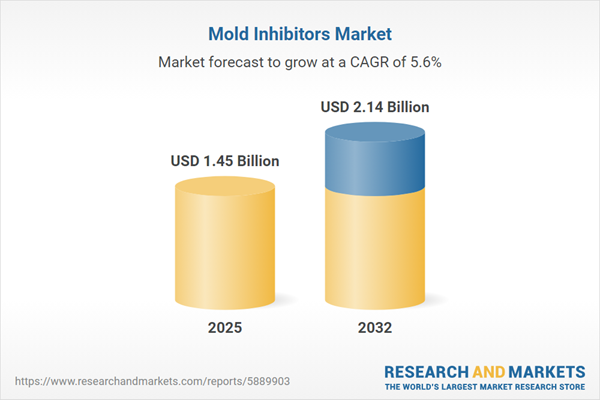Speak directly to the analyst to clarify any post sales queries you may have.
The Mold Inhibitors Market is advancing as global industries focus on safer, longer-lasting products and stricter regulatory standards. As the marketplace transitions toward sustainable, high-performance solutions, organizations require up-to-date intelligence to optimize procurement, compliance, and innovation strategies across applications.
Market Snapshot: Mold Inhibitors Market Size and Growth Trajectory
The Mold Inhibitors Market grew from USD 1.38 billion in 2024 to USD 1.45 billion in 2025. It is expected to continue expanding with a CAGR of 5.63%, reaching USD 2.14 billion by 2032. These figures reflect steady, long-term growth as advancements in mold inhibitor chemistries and demand for shelf-life extension drive broad adoption across food, pharmaceutical, cosmetics, and industrial sectors.
Scope & Segmentation: Market Structure and Coverage
- Type: Natural (bacterial, essential oils, plant-based, yeast) and synthetic (acetates, benzoates, propionates, sorbates) inhibitors are covered to reflect a spectrum from bio-derived to traditional agents.
- Form: Liquid inhibitors (concentrates, solutions) enable automated dosing, while powder formats (fine, granulated) serve dry-mix and pharmaceutical manufacturing.
- Function: Preventative solutions deliver antimicrobial action and shelf-life extension, while safety enhancements target chemical stability and non-toxicity for regulated end uses.
- Application: Cosmetics & personal care (fragrances, haircare, makeup, skincare), feed (aquafeed, cattle, poultry, swine), food & beverages (bakery, beverages, dairy, meat), and pharmaceuticals (capsules, ointments, powders, tablets) demonstrate the market’s cross-industry relevance.
- Regions: Americas (United States, Canada, Mexico, Brazil, Argentina, Chile, Colombia, Peru), Europe, Middle East & Africa (United Kingdom, Germany, France, Russia, Italy, Spain, Netherlands, Sweden, Poland, Switzerland, UAE, Saudi Arabia, Qatar, Turkey, Israel, South Africa, Nigeria, Egypt, Kenya), and Asia-Pacific (China, India, Japan, Australia, South Korea, Indonesia, Thailand, Malaysia, Singapore, Taiwan) ensure comprehensive geographic analysis.
- Companies: The report provides insights on leading and emerging suppliers, including DuPont, Ashland, DSM, Kerry, Brenntag, Corbion, Adisseo Group, BASF SE, and others involved in formulation, supply chain, and distribution advances.
Key Takeaways: Strategic Insights for Decision-Makers
- Advanced mold inhibitors increasingly integrate both natural and synthetic components, responding to consumer demand for bio-based ingredients as well as regulatory shifts toward greener preservatives.
- Digitalization and sensor-driven quality control platforms are enabling real-time monitoring, supporting data-driven decisions in manufacturing and supply chain operations.
- Cross-industry collaborations, including those with academic partners, are expediting development of encapsulated and targeted-delivery inhibitors for specialized requirements, such as high-moisture or extended distribution products.
- Regional dynamics shape inhibitor specification and adoption: stringent regulations in North America and Europe drive innovation, while rapidly industrializing Asia-Pacific markets amplify demand for versatile mold control agents.
- Smaller players may face cost pressure from regulatory and trade factors, increasing the value of strategic alliances, mergers, and vertical integration among larger market participants.
Tariff Impact: Effects of 2025 U.S. Policy Changes
Revised United States tariffs enacted in 2025 are restructuring supply chain strategies and production costs for the mold inhibitor sector. Upward pricing pressure and ingredient sourcing challenges are accelerating the move toward regional manufacturing hubs and nearshoring. Organizations with integrated operations or diversified supplier networks are positioned to adapt more quickly to these changes, while smaller entities may consolidate or form alliances to maintain market access.
Methodology & Data Sources
This report utilizes a hybrid methodology, combining primary interviews with stakeholders in procurement, R&D, and regulatory compliance alongside secondary review of industry publications, trade databases, and government documents. Cross-validation by expert panels ensures accurate trend analysis and market mapping.
Why This Report Matters
- Enables organizations to benchmark supplier strategies and formulation advancements for long-term business planning.
- Offers clarity on regional market requirements, regulatory outlooks, and shifting competitive dynamics to support risk mitigation and opportunity capture.
- Equips leaders with actionable recommendations for technology adoption and supply chain resilience in evolving regulatory and tariff environments.
Conclusion
As end-user needs and compliance expectations evolve, timely insights into mold inhibitor technologies and suppliers are essential. This report offers the strategic context to drive performance, sustainability, and market adaptability in a competitive environment.
Additional Product Information:
- Purchase of this report includes 1 year online access with quarterly updates.
- This report can be updated on request. Please contact our Customer Experience team using the Ask a Question widget on our website.
Table of Contents
3. Executive Summary
4. Market Overview
7. Cumulative Impact of Artificial Intelligence 2025
Companies Mentioned
The companies profiled in this Mold Inhibitors market report include:- Adisseo Group
- Alltech
- Archer-Daniels-Midland Company
- Associated British Foods PLC
- BASF SE
- Bentoli
- Camlin Fine Sciences Ltd.
- Carbion NV.
- ChemPoint by Univar Solutions
- DSM Food Specialties B.V.
- Eastman Chemical Corporation
- Galactic SA
- Glanbia PLC
- Handary S.A.
- Hawkins Watts Limited
- Impextraco NV
- Kemin Industries Inc.
- Kerry Group plc
- Lanxess
- Lesaffre Corporation
- Maverik Oils
- Muscat Chemical
- Niacet Corporation
- Novonesis Group
- Otto Chemie Pvt. Ltd.
- The Perstorp Group by PETRONAS Chemicals Group
Table Information
| Report Attribute | Details |
|---|---|
| No. of Pages | 187 |
| Published | November 2025 |
| Forecast Period | 2025 - 2032 |
| Estimated Market Value ( USD | $ 1.45 Billion |
| Forecasted Market Value ( USD | $ 2.14 Billion |
| Compound Annual Growth Rate | 5.6% |
| Regions Covered | Global |
| No. of Companies Mentioned | 27 |









